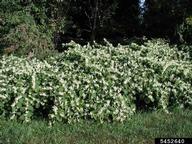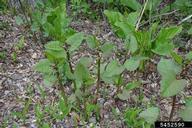| Japanese knotweed | USDA PLANTS Symbol: REJA2 U.S. Nativity: Exotic Habit: Forbs/Herbs Shrub or Subshrub |
| Reynoutria japonica Sieb. & Zucc. |
Jump to: Resources | Images | Distribution Maps | Sources
|
Taxonomic Rank: Magnoliopsida: Polygonales: Polygonaceae |
|
Japanese knotweed is a dense growing shrub reaching heights of 10 ft. (3 m). The semi-woody stem is hollow with enlarged nodes. Leaves are alternate, 6 in. (15.2 cm) long, 3-4 in. (7.6-10 cm) wide and broadly-ovate. Flowering occurs in late summer, when small, greenish-white flowers develop in long panicles in the axils of the leaves. Plants are dioecious (male and female flowers occur on separate plants). Japanese knotweed commonly invades disturbed areas with high light, such as roadsides and stream banks. Reproduction occurs both vegetatively (rhizomes) and seeds, making this plant extremely hard to eradicate. The dense patches shade and displace other plant life and reduce wildlife habitat. Japanese knotweed resembles giant knotweed (Polygonum sachalinense), but giant knotweed is larger and has heart-shaped leaves. Japanese knotweed is native to eastern Asia and was first introduced into North America in the late 1800s. |
|
Identification, Biology, Control and Management Resources
|
| Selected Images from Invasive.org | View All Images at Invasive.org |
 Flower(s); Jan Samanek, Phytosanitary Administration, Bugwood.org Additional Resolutions & Image Usage |
 Plant(s); Leslie J. Mehrhoff, University of Connecticut, Bugwood.org Additional Resolutions & Image Usage |
 Flower(s); Leslie J. Mehrhoff, University of Connecticut, Bugwood.org Additional Resolutions & Image Usage |
 Plant(s); Nanna Borcherdt, Sitka Conservation Society, Bugwood.org Additional Resolutions & Image Usage |
 Flower(s); Leslie J. Mehrhoff, University of Connecticut, Bugwood.org Additional Resolutions & Image Usage |
 Stem(s); stem and leaves in July Steve Manning, Invasive Plant Control, Bugwood.org Additional Resolutions & Image Usage |
 Flower(s); Leslie J. Mehrhoff, University of Connecticut, Bugwood.org Additional Resolutions & Image Usage |
 Foliage; Comparison of leaves of P. sachalinense (right of each pair) and P. cuspidatum Leslie J. Mehrhoff, University of Connecticut, Bugwood.org Additional Resolutions & Image Usage |
 Fruit(s); Jan Samanek, Phytosanitary Administration, Bugwood.org Additional Resolutions & Image Usage |
 Flower(s); Leslie J. Mehrhoff, University of Connecticut, Bugwood.org Additional Resolutions & Image Usage |
 Twig(s)/Shoot(s); Leslie J. Mehrhoff, University of Connecticut, Bugwood.org Additional Resolutions & Image Usage |
 Fruit(s); Jan Samanek, Phytosanitary Administration, Bugwood.org Additional Resolutions & Image Usage |
 Fruit(s); fruit Jil Swearingen, USDI National Park Service, Bugwood.org Additional Resolutions & Image Usage |
 Seed(s); Ken Chamberlain, The Ohio State University, Bugwood.org Additional Resolutions & Image Usage |
 Stem(s); In September James H. Miller, USDA Forest Service, Bugwood.org Additional Resolutions & Image Usage |
 Stem(s); Chris Evans, University of Illinois, Bugwood.org Additional Resolutions & Image Usage |
 Infestation; October, 2007.; Nathan Guyton and Japanese Knotweed Randy Westbrooks, Invasive Plant Control, Inc., Bugwood.org Additional Resolutions & Image Usage |
 Seedling(s); Ohio State Weed Lab , The Ohio State University, Bugwood.org Additional Resolutions & Image Usage |
 Plant(s); Britton, N.L., and A. Brown. 1913. Illustrated flora of the northern states and Canada. Vol. 1: 676. USDA NRCS PLANTS Database , USDA NRCS PLANTS Database, Bugwood.org Additional Resolutions & Image Usage |
| EDDMapS Distribution: This map is incomplete and is based only on current site and county level reports made by experts and records obtained from USDA Plants Database. For more information, visit www.eddmaps.org |
 State List This map identifies those states that list this species on their invasive species list or law. 
|










